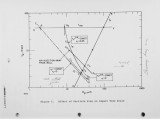| OCR Text |
Show a 100 mm particle. The characteristic pyrolysis time scale is of the order of 2-3 ms at a particle temperature (T ) ~ 1300 K. The burning time scale under diffusion controlled burning is of the order of 30 ms for d = 100 ym. Thus, as discussed above, the two most important time scales are heating and char burning times, both of which are proportional to the square of particle diameter. The total heat up and the burnup time scale versus diameter is plotted in Figure 5 (line APB). For d < 25 ym, the burnup time scale (t. ) is less than t , which is shown for various bulk flow conditions. Thus the w' particles will be burnt before they reach the wall, and their initial ash content will be entrained in the gas phase. There is also plotted the available residence time scale (t ) in the cyclone (line EF). The residence time has been calculated as follows: t = m/rfi* (12) res where m, mass in cyclone at product gas density m, gas flow rate into cyclone. The residence time with the present assumption is independent of particle size. The resdence time line intersects the travel time line at Q. According to this analysis, particles below about 2 ym never reach wall within the available residence time, while particles smaller than 25 ym combust completely before wall impact. * The residence time line is above the intresection point P (Figure 5) since under MHD cyclone combustor conditions, with enriched oxygen and increased transport coefficient to the particles, the time to burn is small. Also line CD may be shifted upwards if free vortex law is not followed. Hence, depending upon the design and operating conditions of cyclone, the intersection point Q may be above or below point P. -20- ^7AVCO EVERETT |


































